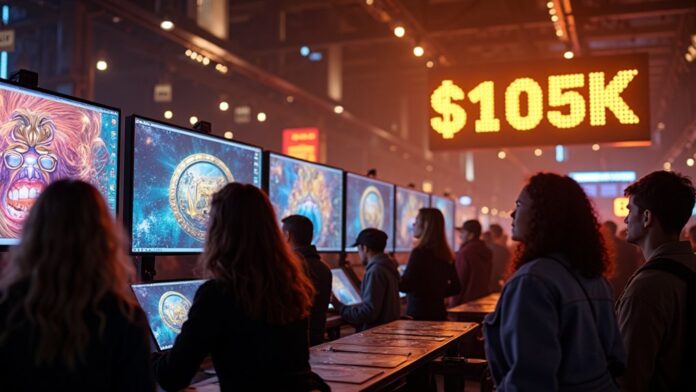The NFT market experienced a modest recovery late in 2024, with trading volumes hitting $1.36 billion, as Bitcoin’s value surged past $105K. Active buyers increased by 55.08%, reaching 826,992, while sellers rose 18.12% to 257,017. Improved market sentiment and regulatory clarity have bolstered caution-driven optimism. This resurgence, amidst Bitcoin’s bullish trend, hints at renewed investor interest and emerging growth opportunities. For insights into this evolving landscape, explore how broader crypto dynamics intertwine with NFTs.
Although the NFT market faced a severe downturn in 2023-2024 with trading volumes dropping over 60% from their peak, early signs of recovery appeared in late 2024. This resurgence was subtly linked to an uptick in market sentiment, driven in part by Bitcoin’s surge past $105K, which historically has a ripple effect on digital asset markets, including NFTs. The correlation between Bitcoin’s performance and NFT market trends became increasingly evident as buyer behavior shifted towards more cautious but optimistic engagement with NFTs. The global NFT market is expected to grow to $152.54 billion by 2030, highlighting the potential for long-term growth despite past challenges.
Despite the turbulent times of early 2023, by December 2024, trading volumeThe total quantity of cryptocurrency traded within a specifi had surged to a notable $1.36 billion. This spike was accompanied by a 55.08% increase in active buyers, totaling 826,992, suggesting a renewed interest and confidence among participants. However, this momentum faced a setback in early 2025 due to broader crypto market corrections, showcasing the intertwined nature of NFT and cryptocurrencyA digital or virtual currency that uses cryptography for sec markets. The number of sellers also rose by 18.12%, reaching 257,017, indicating a balanced, albeit cautious, market sentiment as both buyers and sellers recalibrated their strategies in response to fluctuating market conditions. It’s important to note that the NFT market experienced a massive 62% plunge in revenues in 2023, which was one of the key factors behind the cautious optimism observed in late 2024.
Regulatory developments played an essential role in shaping market sentiment. The SEC’s decision to close its investigation of OpenSea without charges provided much-needed relief, alleviating some regulatory anxieties that had previously dampened buyer behavior. As certainty increased, participants felt a sense of belonging and security, fostering an environment conducive to growth. This regulatory clarity is vital for market stability, as emerging standards and classifications evolve, especially regarding utility NFTs and securities classification.
Amid these changes, the NFT market continued to diversify with new applications. Hybrid models and AI-generated NFTs emerged as innovative trends, capturing the interest of both creators and investors. These advancements contributed to a broader acceptance and integration of NFTs into mainstream digital culture, enhancing the market’s appeal and driving participation. Soulbound tokens, representing non-transferable digital assets tied to an individual, also garnered attention as they offered potential applications in identity verification, gaming, and professional credentials.
However, the market wasn’t without challenges. The decline in speculative interest, environmental concerns, and market saturation posed significant hurdles. These factors contributed to a projected revenue decline of $75 million or 11% in 2025, underscoring the need for sustainable growth strategies. Economic conditions worldwide also played a role, highlighting the necessity for the NFT market to adapt to broader financial landscapes.
The NFT gaming sector, estimated at $0.54 trillion in 2025, emerged as a potential catalyst for revitalizing the market. Its integration with Web3 technologies and the metaverse provided fresh avenues for growth, offering participants new experiences and investment opportunities. This sector’s expansion is likely to influence buyer behavior positively, as it aligns with the evolving digital asset ecosystem.



